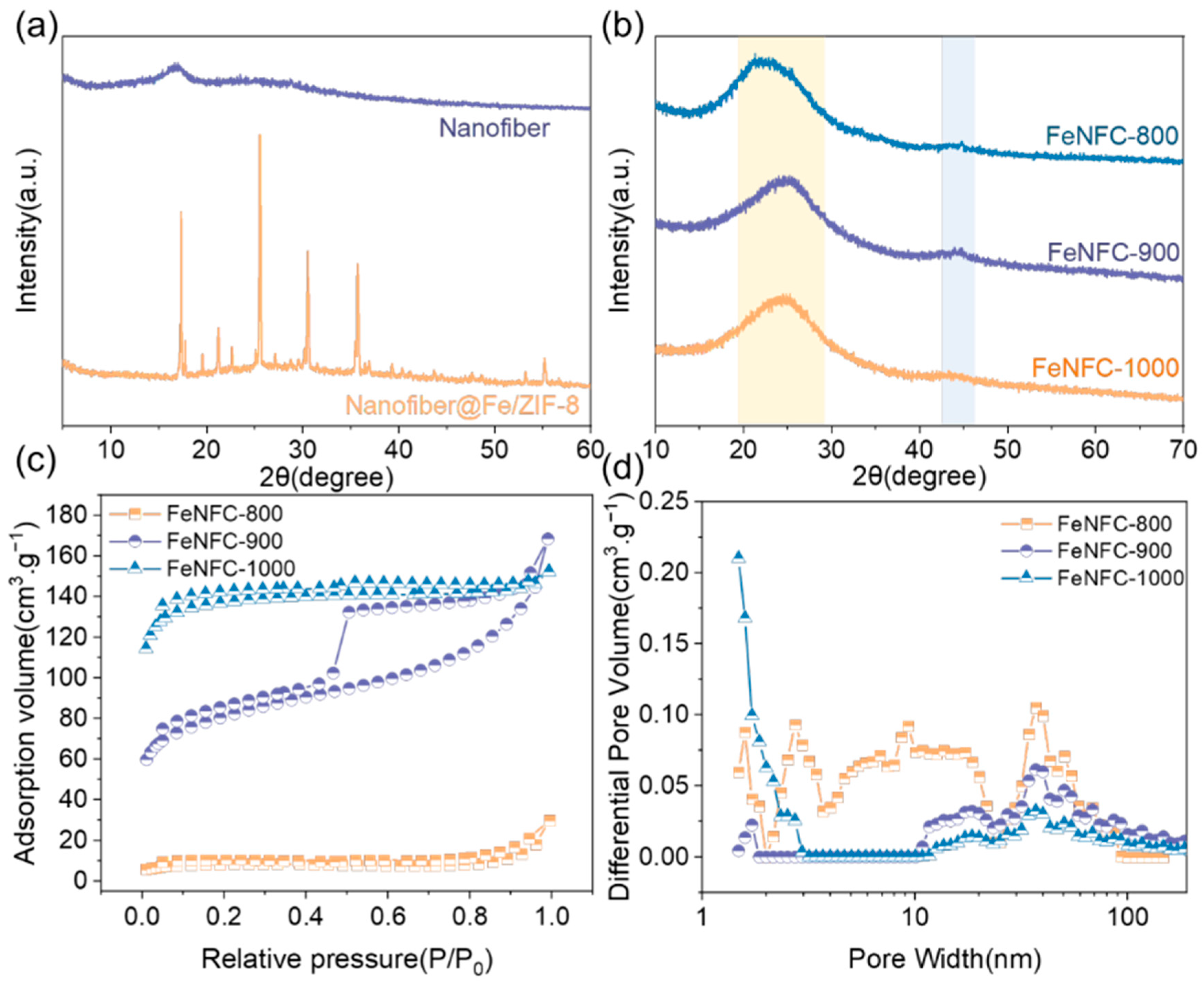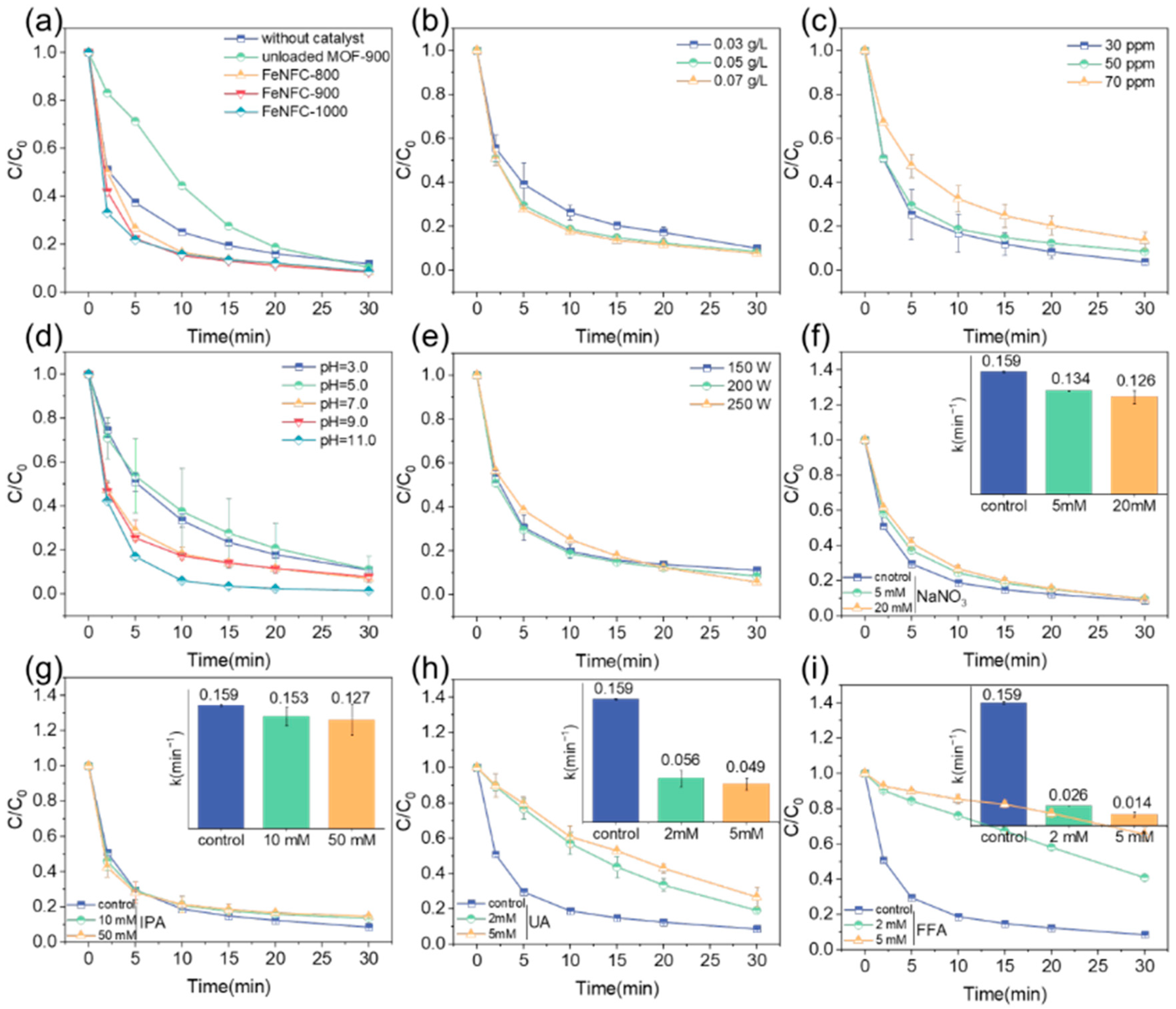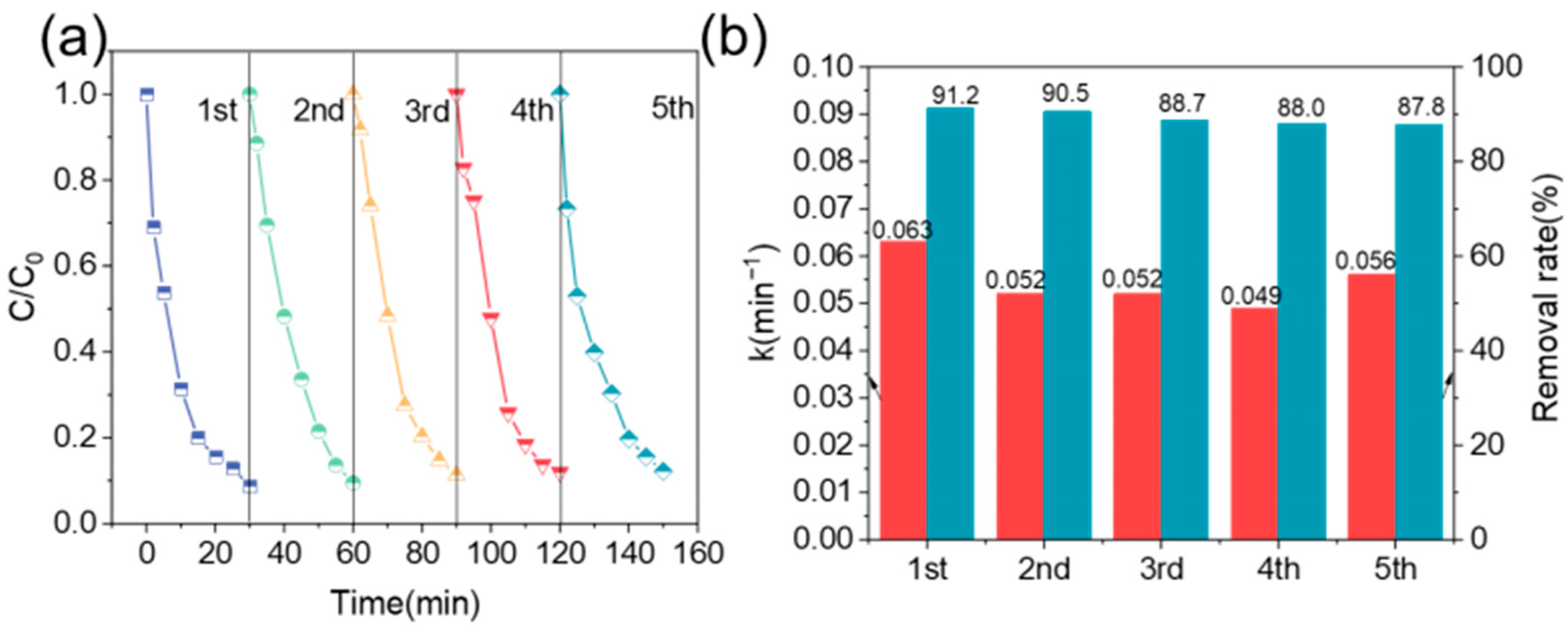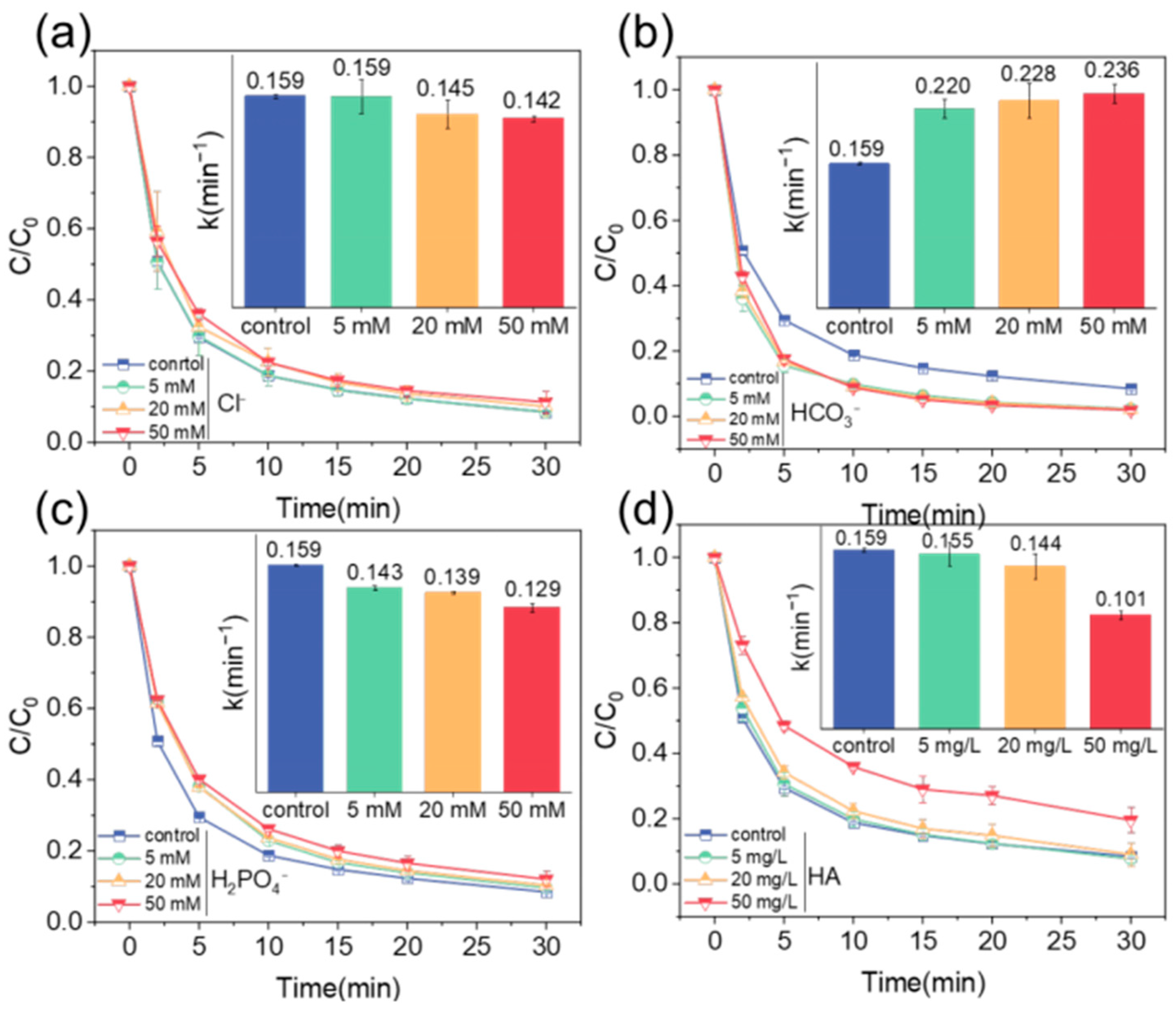Zn/Fe-MOF-Derived Carbon Nanofibers via Electrospinning for Efficient Plasma-Catalytic Antibiotic Removal
Abstract
1. Introduction
2. Results and Discussion
2.1. Characterization of the Catalysts
2.2. Catalytic Performance
2.3. Degradation Mechanism Analysis
2.4. Degradation Pathway and Toxicity Analysis
- (1)
- TTCH first undergoes a demethylation reaction, losing one methyl group (−CH3) to form P1 (m/z = 415); it is speculated that two methyl groups or one methyl group are simultaneously removed. Subsequently, the amide bond of P1 breaks, possibly losing the carbonyl-containing fragment, and is transformed into P2 (m/z = 362). P2 further undergoes a ring-opening reaction of the ring structure, with the larger aromatic ring or heterocyclic ring breaking and losing the polyatomic group (molecular weight of approximately 151), generating P3 (m/z = 211). Ultimately, P3 undergoes the shedding of carboxyl or hydroxyl groups (such as −COOH, with a molecular weight of 45) to form P4 (m/z = 119) and further mineralizes.
- (2)
- TTCH first undergoes a hydroxylation reaction, introducing a hydroxyl group to form P5 (m/z = 460, possibly accompanied by methyl substitution). P5 then undergoes a dehydrogenation reaction, losing one hydrogen atom (−H, molecular weight 1) and converting to P6 (m/z = 459). P6 undergoes glycosidic bond cleavage or side chain shedding, losing a larger fragment (with a molecular weight of approximately 186) and generating P7 (m/z = 273). P7 continues to undergo deamination reaction (−NH2, molecular weight 16) or decarboxylation reaction, losing small molecule groups, generating P8 (m/z = 231), and eventually gradually mineralizes.
- (3)
- TTCH undergoes deamination first, generating P9 (m/z = 428). P9 then undergoes ring structure cleavage and may lose the nitrogen-containing heterocyclic fragment (with a molecular weight of approximately 110), transforming into P10 (m/z = 318). P10 loses a group with a molecular weight of approximately 39 through either bond breakage or alkyl chain shedding, generating P11 (m/z = 279). P11 further undergoes dehalogenation or demethylation reactions, generating P12 (m/z = 221), which is ultimately completely degraded into inorganic small molecules.
3. Materials and Methods
3.1. Experimental Setup
3.2. Energy Yield Analysis
3.3. Synthesis of ZIF-8@Fe
3.4. Synthesis of FeNFC
3.5. Experimental Methods
4. Conclusions
Supplementary Materials
Author Contributions
Funding
Data Availability Statement
Conflicts of Interest
References
- Deng, J.; Feng, S.; Ma, X.; Li, J.; Gao, N. Research Progress on Advanced Oxidation Technology of Homogeneous activated peroxymonosulfate. Technol. Water Treat. 2015, 41, 13–19. [Google Scholar]
- Wang, Q.; Wang, T.; Qu, G.; Zhang, Y.; Sun, Q.; Guo, X.; Jia, H. High-efficient removal of tetrabromobisphenol A in aqueous by dielectric barrier discharge: Performance and degradation pathways. Sep. Purif. Technol. 2020, 240, 116615. [Google Scholar] [CrossRef]
- Liu, X. Research on the Application of Surface Plasma Resonance Technology in Environmental Pollutant Monitoring. Low Carbon World 2016, 9, 19–20. [Google Scholar]
- Meloni, E.; Cafiero, L.; Renda, S.; Martino, M.; Pierro, M.; Palma, V. Ru- and Rh-Based Catalysts for CO2 Methanation Assisted by Non-Thermal Plasma. Catalysts 2023, 13, 488. [Google Scholar] [CrossRef]
- Fan, Z. Pilot Study on the Treatment of Printing and Dyeing Wastewater by Dielectric Barrier Discharge Plasma. Master’s Thesis, Taiyuan University of Technology, Taiyuan, China, 2021. [Google Scholar]
- Shi, C.; Wang, S.; Ge, X.; Deng, S.; Chen, B.; Shen, J. A review of different catalytic systems for dry reforming of methane: Conventional catalysis-alone and plasma-catalytic system. J. CO2 Util. 2021, 46, 101462. [Google Scholar] [CrossRef]
- Feng, J.; Sun, X.; Li, Z.; Hao, X.; Fan, M.; Ning, P.; Li, K. Plasma-assisted reforming of methane. Adv. Sci. 2022, 9, 2203221. [Google Scholar] [CrossRef]
- Andersen, J.A.; Christensen, J.M.; Østberg, M.; Bogaerts, A.; Jensen, A.D. Plasma-catalytic dry reforming of methane: Screening of catalytic materials in a coaxial packed-bed DBD reactor. Chem. Eng. J. 2020, 397, 125519. [Google Scholar] [CrossRef]
- Ansari, M.; Mahvi, A.H.; Salmani, M.H.; Sharifian, M.; Fallahzadeh, H.; Ehrampoush, M.H. Dielectric barrier discharge plasma combined with nano catalyst for aqueous amoxicillin removal: Performance modeling, kinetics and optimization study, energy yield, degradation pathway, and toxicity. Sep. Purif. Technol. 2020, 251, 117270. [Google Scholar] [CrossRef]
- Cheng, J.; Xie, Y.; Wei, Y.; Xie, D.; Sun, W.; Zhang, Y.; Li, M.; An, J. Degradation of tetracycline hydrochloride in aqueous via combined dielectric barrier discharge plasma and Fe-Mn doped AC. Chemosphere 2021, 286, 131841. [Google Scholar] [CrossRef]
- Li, W.; Zhang, Y.; Li, Q.; Zhang, G. Metal−organic Framework Composite Membranes: Synthesis and Separation Applications. Chem. Eng. Sci. 2015, 135, 232–257. [Google Scholar] [CrossRef]
- Hong, D.H.; Shim, H.S.; Ha, J.; Moon, H.R. MOF-on-MOF Architectures: Applications in Separation, Catalysis, and Sensing. Bull. Korean Chem. Soc. 2021, 42, 956–969. [Google Scholar] [CrossRef]
- Lou, X.; Zhi, F.; Sun, X.; Wang, F.; Hou, X.; Lv, C.; Hu, Q. Construction of co-immobilized laccase and mediator based on MOFs membrane for enhancing organic pollutants removal. Chem. Eng. J. 2023, 451, 138080. [Google Scholar] [CrossRef]
- Niu, F.; Sun, Y.; Yang, S.; Wang, J.; Mi, J.; Feng, Y. Research Progress on the Purification of Gas Pollutants by MOFs/Electrospun Nanofibers and Their Derivative Materials. Chem. Ind. Eng. Prog. 2024, 1–21. [Google Scholar] [CrossRef]
- Hu, L.; Bui, V.T.; Pal, S.; Guo, W.; Subramanian, A.; Kisslinger, K.; Fan, S.; Nam, C.Y.; Ding, Y.; Lin, H. In Situ Growth of Crystalline and Polymer-Incorporated Amorphous ZIFs in Polybenzimidazole Achieving Hierarchical Nanostructures for Carbon Capture. Small 2022, 18, 2201982. [Google Scholar] [CrossRef]
- Xiao, W. Preparation and Performance Study of In-Situ Grown ZIF-8 Reinforced, Toughened and Self-healing Materials. Master’s Thesis, Beijing University of Chemical Industry, Beijing, China, 2024. [Google Scholar]
- Zhang, H.; Zhao, B.; Wang, H.; Wang, J.; Teng, Y.; Sun, Y.; Li, Y.; Wang, C. Water-/Oil-repellent polyacrylonitrile nanofiber air filter modified with silica nanoparticles and fluorine compounds. ACS Appl. Nano Mater. 2022, 5, 8131–8141. [Google Scholar] [CrossRef]
- Huang, H.; Song, Y.; Zhang, Y.; Li, Y.; Li, J.; Lu, X.; Wang, C. Electrospun nanofibers: Current progress and applications in food systems. J. Agric. Food Chem. 2022, 70, 1391–1409. [Google Scholar] [CrossRef]
- Sadakiyo, M. Support effects of metal–organic frameworks in heterogeneous catalysis. Nanoscale 2022, 14, 3398–3406. [Google Scholar] [CrossRef] [PubMed]
- Meng, J. Based on ZIF-67 Derived Carbon Materials Preparation and Dye Adsorption Study. Master’s Thesis, Changchun University of Technology, Changchun, China, 2025. [Google Scholar]
- Guo, S.; Li, Z.; Li, Y.; Zeng, Z.; Lv, J.; Huang, S.; Wang, Y.; Ma, X. CoMn catalysts derived from partial decomposed layered CoMn-MOF materials for higher alcohol synthesis from syngas. Chem. Eng. J. 2023, 463, 142359. [Google Scholar] [CrossRef]
- Wang, S.; Gao, Z.; Song, G.; Yu, Y.; He, W.; Li, L.; Wang, T.; Fan, F.; Li, Y.; Zhang, L.; et al. Copper oxide hierarchical morphology derived from MOF precursors for enhancing ethanol vapor sensing performance. J. Mater. Chem. C 2020, 8, 9671–9677. [Google Scholar] [CrossRef]
- Zhong, Q.; Ye, X.; Zeng, J.; Cai, L.; Wang, Y.; Hong, J. Efficient decolorization of azo organics by singlet oxygen from activating PMS with octahedral structured FMN-700. China Environ. Sci. 2023, 43, 6374–6385. [Google Scholar]
- Miao, P.; Cheng, K.; Li, H.; Gu, J.; Chen, K.; Wang, S.; Wang, D.; Liu, T.; Xu, B.; Kong, J. Poly(dimethylsilylene)diacetylene-Guided ZIF-Based Heterostructures for Full Ku-Band Electromagnetic Wave Absorption. ACS Appl. Mater. Interfaces 2019, 11, 17706. [Google Scholar] [CrossRef]
- Thommes, M.; Kaneko, K.; Neimark, A.V.; Olivier, J.P.; Rodríguez-Reinoso, F.; Rouquerol, J.; Sing, K.S. Physisorption of gases, with special reference to the evaluation of surface area and pore size distribution (IUPAC technical report). Pure Appl. Chem. 2015, 87, 1051–1069. [Google Scholar] [CrossRef]
- Xie, D.; Guo, Y.; Zhao, D. Fractal characteristics of adsorption pore of shale based on low temperature nitrogen experiment. J. China Coal Soc. 2014, 39, 2466–2472. [Google Scholar]
- Sing, K.S.W.; Williams, R.T. Physisorption hysteresis loops and the characterization of nanoporous materials. AdSorpt. Sci. Technol. 2004, 22, 773–782. [Google Scholar] [CrossRef]
- Liu, H.; Wu, S.; Jiang, X.; Wang, G.; Cao, Q.; Qiu, P.; Oin, Y. The configuration ana lysis of the adsorption isotherm of nitrogen in low temperature with the lignite char produced under fast pyrolysis. J. China Coal Soc. 2005, 30, 507–510. [Google Scholar]
- Yang, T.; An, L.; Zeng, G.; Jiang, M.; Li, J.; Liu, C.; Jia, J.; Ma, J. Efficient removal of p-arsanilic acid and arsenate by Fe(II)/peracetic acid (Fe(II)/PAA) and PAA processes. Water Res. 2023, 241, 120091. [Google Scholar] [CrossRef]
- Shen, T.; Wang, X.; Li, J.; Yang, C.; Xu, P.; Chai, H.; Wang, P.; Zhang, G. Construction of 3D ternary layered double hydroxides on nickel foam for enhancing dielectric barrier discharge plasma to degrade DUR: Performance. mechanism and energy efficiency. Chem. Eng. J. 2023, 455, 140790. [Google Scholar] [CrossRef]
- Chen, Y.; Sun, X.; Zheng, L.; Liu, Y.; Zhao, Y.; Huang, S.; Li, S. Synergistic catalysis degradation of amoxicillin by DBD plasma-catalyst system constructed by DBD plasma and Ce0.5Bi0.5VO4/HCP coating. Process Saf. Environ. Prot. 2024, 181, 416–428. [Google Scholar] [CrossRef]
- Zhang, H.; Wang, J.; Teng, Y.; Jia, S.; Huang, H.; Li, Y.; Wang, C. Ce-MOF composite electrospinning as antibacterial adsorbent for the removal of 2,4-dichlorophenoxyacetic acid. Chem. Eng. J. 2023, 462, 142195. [Google Scholar] [CrossRef]
- He, D.; Zhu, K.; Huang, J.; Shen, Y.; Lei, L.; He, H.; Chen, W. N,S co-doped magnetic mesoporous carbon nanosheets for activating peroxymonosulfate to rapidly degrade tetracycline: Synergistic effect and mechanism. J. Hazard. Mater. 2022, 424, 127569. [Google Scholar] [CrossRef]
- Li, X.; Wang, S.; Xu, B.; Zhang, X.; Xu, Y.; Yu, P.; Sun, Y. MOF etching-induced Co-doped hollow carbon nitride catalyst for efficient removal of antibiotic contaminants by enhanced perxymonosulfate activation. Chem. Eng. J. 2022, 441, 136074. [Google Scholar] [CrossRef]
- Zhang, T.; Liu, Y.; Rao, Y.; Li, X.; Yuan, D.; Tang, S.; Zhao, Q. Enhanced photocatalytic activity of TiO2 with acetylene black and persulfate for degradation of tetracycline hydrochloride under visible light. Chem. Eng. J. 2020, 384, 123350. [Google Scholar] [CrossRef]
- Chen, C.; Ma, C.; Yang, Y.; Demeestere, K.; Nikiforovh, A.; Hulle, S.V. Degradation of micropollutants in secondary wastewater effluent using nonthermal plasma-based AOPs: The roles of free radicals and molecular oxidants. Water Res. 2023, 235, 119881. [Google Scholar] [CrossRef] [PubMed]






Disclaimer/Publisher’s Note: The statements, opinions and data contained in all publications are solely those of the individual author(s) and contributor(s) and not of MDPI and/or the editor(s). MDPI and/or the editor(s) disclaim responsibility for any injury to people or property resulting from any ideas, methods, instructions or products referred to in the content. |
© 2025 by the authors. Licensee MDPI, Basel, Switzerland. This article is an open access article distributed under the terms and conditions of the Creative Commons Attribution (CC BY) license (https://creativecommons.org/licenses/by/4.0/).
Share and Cite
Xia, Y.; Tao, S.; Liu, Y.; Zhao, C.; Qiao, W.; Chen, S.; Ruan, J.; Zhang, M.; Gu, C. Zn/Fe-MOF-Derived Carbon Nanofibers via Electrospinning for Efficient Plasma-Catalytic Antibiotic Removal. Catalysts 2025, 15, 944. https://doi.org/10.3390/catal15100944
Xia Y, Tao S, Liu Y, Zhao C, Qiao W, Chen S, Ruan J, Zhang M, Gu C. Zn/Fe-MOF-Derived Carbon Nanofibers via Electrospinning for Efficient Plasma-Catalytic Antibiotic Removal. Catalysts. 2025; 15(10):944. https://doi.org/10.3390/catal15100944
Chicago/Turabian StyleXia, Ying, Shaoqun Tao, Yu Liu, Chenyu Zhao, Weichuan Qiao, Sen Chen, Jingqi Ruan, Ming Zhang, and Cheng Gu. 2025. "Zn/Fe-MOF-Derived Carbon Nanofibers via Electrospinning for Efficient Plasma-Catalytic Antibiotic Removal" Catalysts 15, no. 10: 944. https://doi.org/10.3390/catal15100944
APA StyleXia, Y., Tao, S., Liu, Y., Zhao, C., Qiao, W., Chen, S., Ruan, J., Zhang, M., & Gu, C. (2025). Zn/Fe-MOF-Derived Carbon Nanofibers via Electrospinning for Efficient Plasma-Catalytic Antibiotic Removal. Catalysts, 15(10), 944. https://doi.org/10.3390/catal15100944






